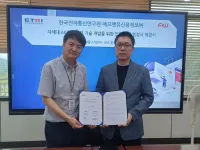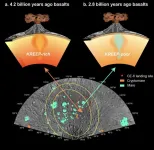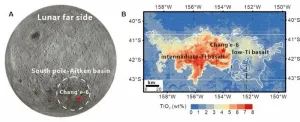(Press-News.org) mRNA vaccines saved lives during the COVID-19 pandemic, but older people had less of an immune response to the vaccines than did younger adults. Why? Boston Children’s researchers, led by Byron Brook, PhD, and Ofer Levy, MD, PhD, have found some answers, while providing proof-of-concept of a new system that can model vaccine responses in a dish.
The test system, described in a paper out today in iScience, is called MEMPHIS (Modular Evaluation of immunogenicity using Multi-Platform Human In vitro Systems). It analyzes whole human blood from people of different age groups and applies both proteomics and targeted assays to measure the production of cytokines (immune signaling proteins) induced by mRNA vaccines.
“Our excitement here is the ability to model responses to mRNA vaccines outside the body in an age-specific fashion, which we demonstrate for the first time,” says Levy, who heads the Precision Vaccines Program at Boston Children’s. “Our model gives us insight into vaccine activity in vulnerable populations.” This, in turn, could help expedite the search for more effective vaccines.
Multi-pronged monitoring
The team collected blood samples from people in different age groups and added the Pfizer/BioNTech COVID mRNA vaccine to the samples. Extensive tests, including proteomics and systems biology approaches, then measured immune activation in response to the vaccine.
This approach identified muted innate immune responses in people over age 60 as compared with those age 18 to 50. In particular, older adults showed an impaired ability to support TH1 immunity, with diminished early inflammatory responses, and lower levels of four key cytokines (CXCL10, IL-1RA, IFN-g, and CCL4), biomarkers that signify generation of a larger immune response.
“The early innate response to mRNA vaccines is critical in instructing the adaptive immune system, triggering maturation of CD4 T cells and supporting downstream cellular and antibody responses that are long-lived,” explains Brook.
The lower initial response associated with advancing age, also seen in mice, may explain why immunity waned more quickly in older adults, the researchers say.
While mouse studies have traditionally been considered a gold standard for research, they are expensive, time-consuming, and don’t always accurately capture human immune biology. In 2022, Congress passed the FDA Modernization Act 2.0, which allows for alternatives to animal testing, including human cell and organoid models alongside systems biology approaches.
Levy emphasizes that their MEMPHIS test system, for which they’ve filed a patent, is an exemplar of this new approach. The system provides a nimbler way to predict age-specific human vaccine responses, allowing multiple vaccine doses and vaccine adjuvants — compounds that boost the immune response, of particular interest in Levy’s lab — to be tested simultaneously in samples from the same person.
“If we could elicit a young-adult-like innate immune response in an elder, we might be able to provide more protection,” says Brook.
De-risking vaccine development for infants and elders
Brook and Levy are now planning a similar study in newborn infants, who have distinct immune systems and vaccine responses. They also want to use their assay to find biomarkers in the blood that predict which mRNA vaccine is most likely to be effective.
“We want to accelerate and de-risk vaccine development using human in vitro systems and eventually be able to select which vaccine and adjuvant are optimal for each population,” says Levy.
Levy, Brook, David Dowling, PhD, Simon van Haren, PhD, and other study coauthors are named inventors on patents related to human in vitro modeling of vaccine responses and vaccine approaches. Levy is also a co-founder of and advisor to Ovax, Inc. See the paper for further disclosures and acknowledgements. To inquire about this technology, contact Christopher Henley, JD, in Boston Children’s Technology & Innovation Office.
About Boston Children’s Hospital
Boston Children’s Hospital is ranked among the best children’s hospitals in the nation
in the nation by U.S. News & World Report and is a pediatric teaching affiliate of Harvard Medical School. Home to the world’s largest research enterprise based at a pediatric medical center, its discoveries have benefited both children and adults since 1869. Today, 3,000 researchers and scientific staff, including 14 members of the National Academy of Sciences, 37 members of the National Academy of Medicine and 13 Howard Hughes Medical Investigators comprise Boston Children’s research community. Founded as a 20-bed hospital for children, Boston Children’s is now a 485-bed comprehensive center for pediatric and adolescent health care. For more, visit our Answers blog and follow us on Facebook, YouTube, and LinkedIn.
END
In vitro model enables study of age-specific responses to COVID mRNA vaccines
2024-11-15
ELSE PRESS RELEASES FROM THIS DATE:
Sitting too long can harm heart health, even for active people
2024-11-15
More time spent sitting, reclining or lying down during the day may increase the risk of cardiovascular disease (CVD) and death, according to a study in JACC, the flagship journal of the American College of Cardiology, and presented at the American Heart Association’s Scientific Sessions 2024. More than roughly 10-and-a-half hours of sedentary behavior per day was significantly linked with future heart failure (HF) and cardiovascular (CV) death, even among people meeting recommended levels of exercise.
“Our findings support cutting back on sedentary time to reduce cardiovascular risk, with 10.6 hours a day marking a potentially key threshold ...
International cancer organizations present collaborative work during oncology event in China
2024-11-15
XI’AN, CHINA [November 15, 2024] — The National Comprehensive Cancer Network® (NCCN®)—an alliance of leading cancer centers in the United States—is taking part in the Fourth International Congress of the Asian Oncology Society and the Chinese Congress on Holistic Integrative Oncology (2024 CCHIO) sponsored by the China Anti-Cancer Association (CACA), Chinese Institute of Development Strategy on Holistic Integrative Medicine, and Asian Oncology Society (AOS). The three-day event highlights international collaborations to improve cancer treatment and outcomes across China and beyond.
“NCCN ...
One or many? Exploring the population groups of the largest animal on Earth
2024-11-15
FROM: James Urton
University of Washington
206-543-2580
jurton@uw.edu
(Note: researcher contact information at the end)
Hunted nearly to extinction during 20th century whaling, the Antarctic blue whale, the world’s largest animal, went from a population size of roughly 200,000 to little more than 300. The most recent estimate in 2004 put Antarctic blue whales at less than 1% of their pre-whaling levels.
But is this population recovering? Is there just one population of Antarctic blue whales, or multiple? Do these questions matter for conservation?
A team led by Zoe Rand, a University of Washington doctoral student, tackles these questions ...
ETRI-F&U Credit Information Co., Ltd., opens a new path for AI-based professional consultation
2024-11-15
A group of South Korean researchers has decided to utilize AI technology to support customer counseling services. Through this, it will provide a significant boost to the performance and efficiency of counselors in various industries, while improving the overall quality of customer counseling services, ultimately making it easier to meet the customers’ needs and expectations while opening up the possibility for realizing new values.
Electronics and Telecommunications Research Institute (ETRI) announced that ...
New evidence links gut microbiome to chronic disease outcomes
2024-11-15
The gut microbiome, an ecosystem of trillions of microorganisms in the human digestive tract, has been increasingly linked to chronic diseases. Research led by Dr. Connor Prosty and his team at McGill University consolidates recent findings that demonstrate a causal role for the gut microbiome in the progression of multiple diseases, ranging from gastrointestinal conditions to immune-related and psychiatric disorders. Published in eGastroenterology, this narrative review examines how manipulating the gut microbiome ...
Family Heart Foundation appoints Dr. Seth Baum as Chairman of the Board of Directors
2024-11-15
Family Heart Foundation Appoints Dr. Seth Baum as Chairman of the Board of Directors
Dr. Seth Baum, Florida Atlantic University, Named Chairman of the Family Heart Foundation’s Board of Directors
The Family Heart Foundation® is proud to announce the appointment of Dr. Seth Baum as the Board of Directors Chairman. An esteemed expert in preventive cardiology and lipidology, Dr. Baum has insights and extensive experience that will contribute to the Foundation’s strategic mission to increase awareness for lay public, expand screening for high-risk populations, improve understanding and education for healthcare teams, and promote ...
New route to ‘quantum spin liquid’ materials discovered for first time
2024-11-15
A new route to materials with complex ‘disordered’ magnetic properties at the quantum level has been produced by scientists for the first time.
The material, based on a framework of ruthenium, fulfils the requirements of the ‘Kitaev quantum spin liquid state’ - an elusive phenomenon that scientists have been trying to understand for decades.
Published in Nature Communications the study, by scientists at the University of Birmingham, offers an important step towards achieving and controlling quantum materials with sought-after new properties that do not follow ...
Chang’e-6 basalts offer insights on lunar farside volcanism
2024-11-15
Basalt samples returned by the Chang’e-6 mission have revealed volcanic events on the lunar farside at 2.8 billion years ago (Ga) and 4.2 Ga, according to research conducted by Prof. LI Qiuli’s lab at the Institute of Geology and Geophysics of the Chinese Academy of Sciences. This work was recently published in Nature.
“Unraveling the volcanic history of the lunar farside is crucial for understanding the hemispheric dichotomy of the Moon,” said Prof. LI.
The asymmetry between the Moon’s nearside and farside—encompassing differences in basalt distribution, topography, crustal thickness, and thorium ...
Chang’e-6 lunar samples reveal 2.83-billion-year-old basalt with depleted mantle source
2024-11-15
The Moon has a global dichotomy, with its near and far sides having different geomorphology, topography, chemical composition, crustal thickness, and evidence of volcanism.
To better understand this dichotomy, Professor XU Yigang’s team from the Guangzhou Institute of Geochemistry of the Chinese Academy of Sciences investigated lunar soil samples from the far side South Pole-Aitken (SPA) Basin of the Moon returned by the Chang’e-6 mission.
Their work was published in Science on Nov. 15.
“The samples returned by Chang’e-6 provide a best opportunity to investigate the lunar global dichotomy,” said Professor ...
Zinc deficiency promotes Acinetobacter lung infection: study
2024-11-15
Dietary zinc deficiency promotes lung infection by Acinetobacter baumannii bacteria — a leading cause of ventilator-associated pneumonia, according to a new study published Nov. 15 in the journal Nature Microbiology.
A Vanderbilt University Medical Center-led team of researchers discovered an unexpected link between the pro-inflammatory cytokine interleukin-13 (IL-13) and A. baumannii lung infection, and they demonstrated that blocking IL-13 prevented infection-associated death in an animal model.
The findings suggest that anti-IL-13 antibodies, which are FDA-approved for use in humans, may protect against bacterial pneumonia in patients with zinc deficiency.
“To ...




